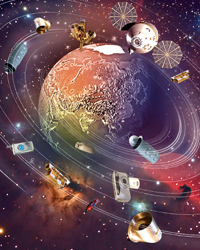INDIAN ARMED FORCES CHIEFS ON
OUR RELENTLESS AND FOCUSED PUBLISHING EFFORTS

SP Guide Publications puts forth a well compiled articulation of issues, pursuits and accomplishments of the Indian Army, over the years

I am confident that SP Guide Publications would continue to inform, inspire and influence.

My compliments to SP Guide Publications for informative and credible reportage on contemporary aerospace issues over the past six decades.
Dangerous Space Debris

NEWS
Orbiting junk compelled NASA to order astronauts aboard the connected International Space Station (ISS) and shuttle Discovery to move out of the way of a piece of debris on Sunday, March 22. Discovery’s pilots fired the ship’s thrusters to reorient the two spacecraft, thereby making way for a small discarded piece from a 10-year-old Chinese satellite rocket motor that was to have hurtled pass uncomfortably close during a planned spacewalk. Space debris is becoming an ever increasing challenge, Flight Director Kwatsi Alibaruho said the same evening. When it comes to dodging junk, it’s a big deal. It’s very tiring. Sometimes it’s exhausting.
VIEWS
Firing the Discovery’s thrusters, astronauts aboard the space shuttle created a slow, natural drag of about a foot per second, placing the shuttle and space station in a belly facing forward position. After about three hours, there was enough room for the offending 4-inch piece of junk to careen past without a collision. This, however, is not an isolated occurrence. The ISS appears to perpetually be in danger of colliding with a vast number of space debris, also called space junk, circling similar orbits. Earlier in the month, the spectre of a collision had forced the three ISS residents to take shelter in their emergency get-away capsule. That was not all, just a week prior to the incident on March 22, right before Discovery’s arrival, the space station had to dodge yet another piece of a busted-up Soviet satellite.
How does one define space debris? These are objects discarded by humans that orbit around the Earth, whooshing around aimlessly. From spent rocket motors and defunct satellites to explosion fragments, space debris also constitute objects that may have accidentally slipped out of the hands of astronauts during space walks or extra-vehicular activity (EVA). Famous Indian origin astronaut Sunita Williams lost a camera during EVA. But such items, mainly because of the proximity of their orbital path, reenter the Earth’s atmosphere and burn up. The real culprits are the explosions. The largest man-made space debris in history was the anti-satellite weapon test conducted by China on January 11, 2007. The incident was estimated to have created 23,000 pieces of trackable debris (about golf ball size or larger), over 35,000 pieces of 1 cm or larger and one million pieces of 1 mm or larger. As the explosion took place at higher orbit altitude compared to the previous tests, the deorbit time is likely to be in excess of 35 years. An incident on February 10 drove home the grave danger posed by space debris when the deactivated Kosmos-2251 and an operational Iridium 33 collided in space over northern Siberia. The relative speed of impact, approximately 42,000 km per hour, pulverised both satellites, consequently inflating the ominous pile of 600,000-plus pieces of junk already floating in space.
Even as the menace rapidly acquires proportions similar to that of global warming, a number of alternatives are being thought of to check the generation of additional space debris. Passivation of spent upper stages by the release of residual fuels is one such measure which could decrease the risk of onorbit explosions. Yet another mitigatory step—that should be made not just mandatory but also included as part and parcel of future satellite designs—would be to deorbit satellites at the end of their operational life. If a direct and controlled deorbit is not feasible (requiring too much fuel), the satellites should at least be brought to lower orbits and slowed down through electrodynamic terminator tethers wherein atmospheric drag would cause them to deorbit within a reasonable timeframe. In case of very high orbital altitudes, such as in the geostationary ring, the satellites could be parked in a marked graveyard where no operational satellites would operate.





